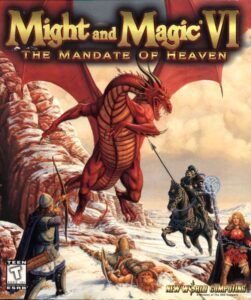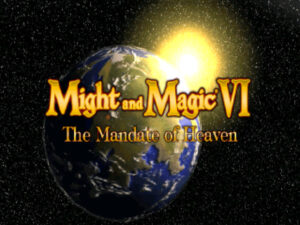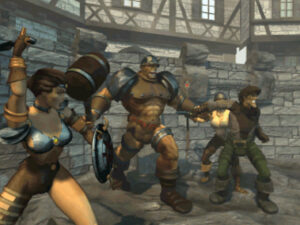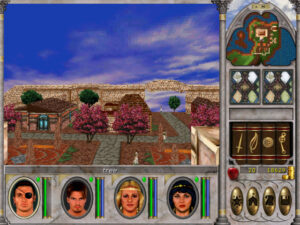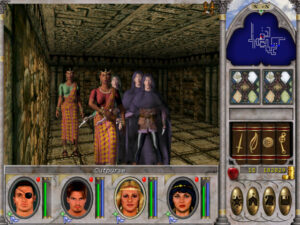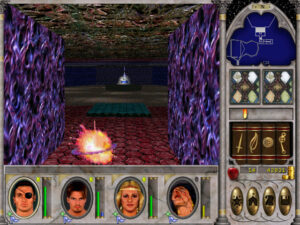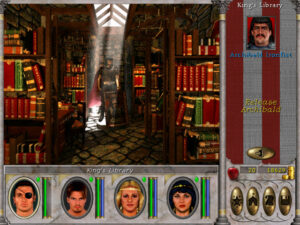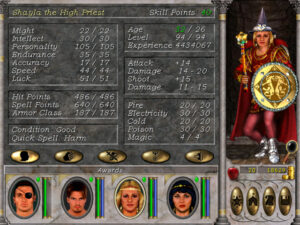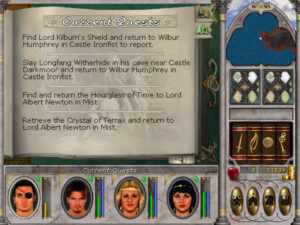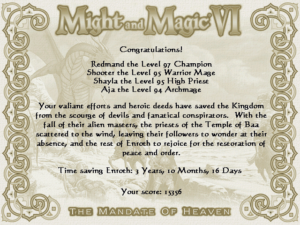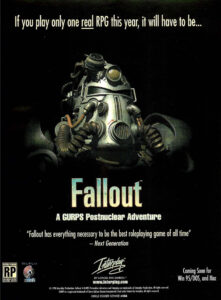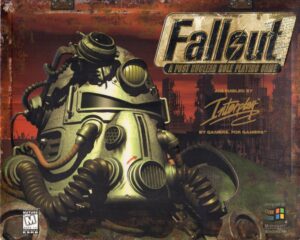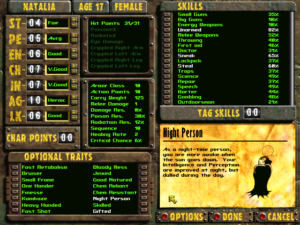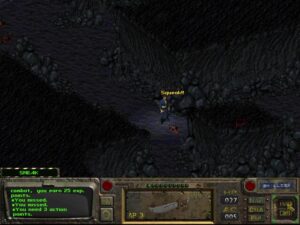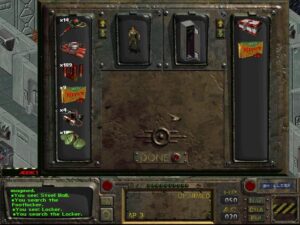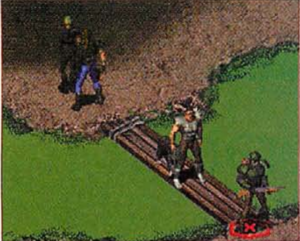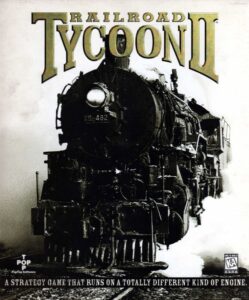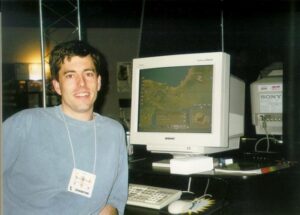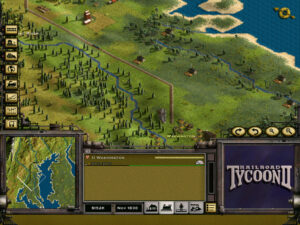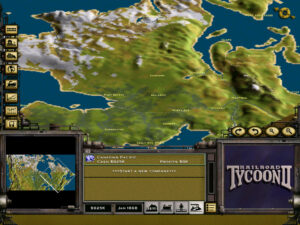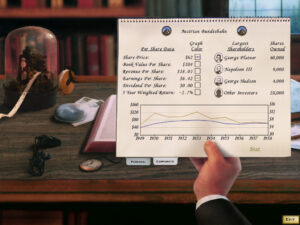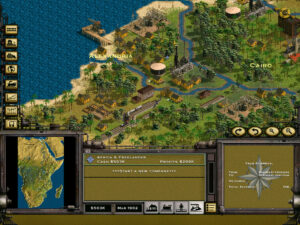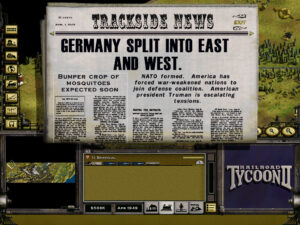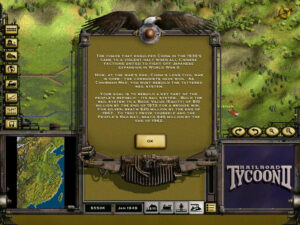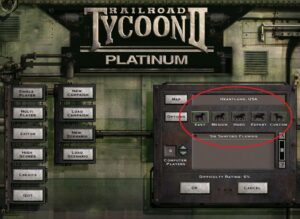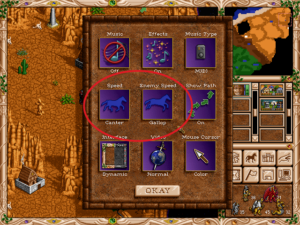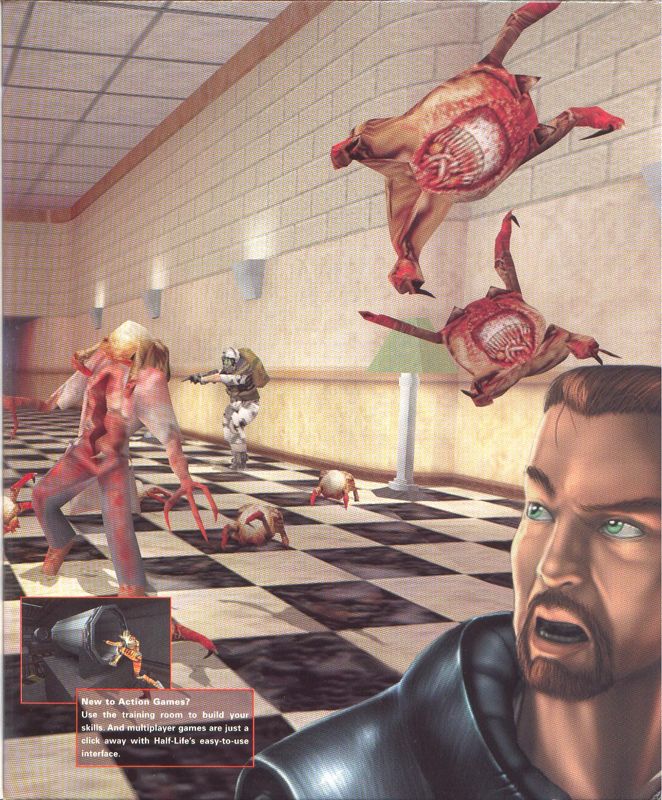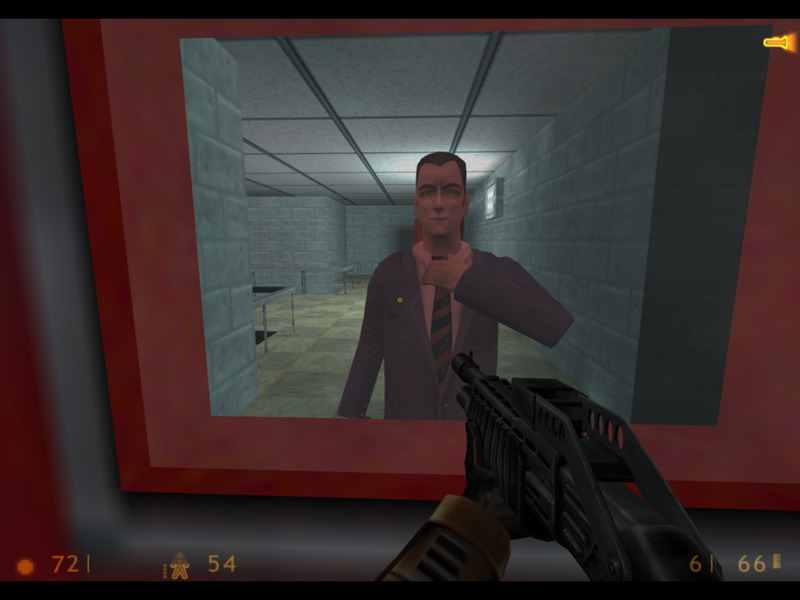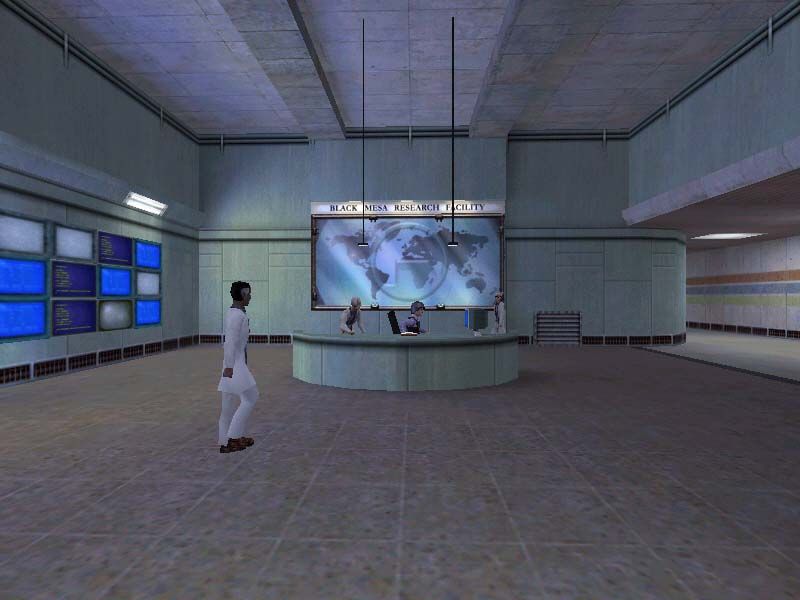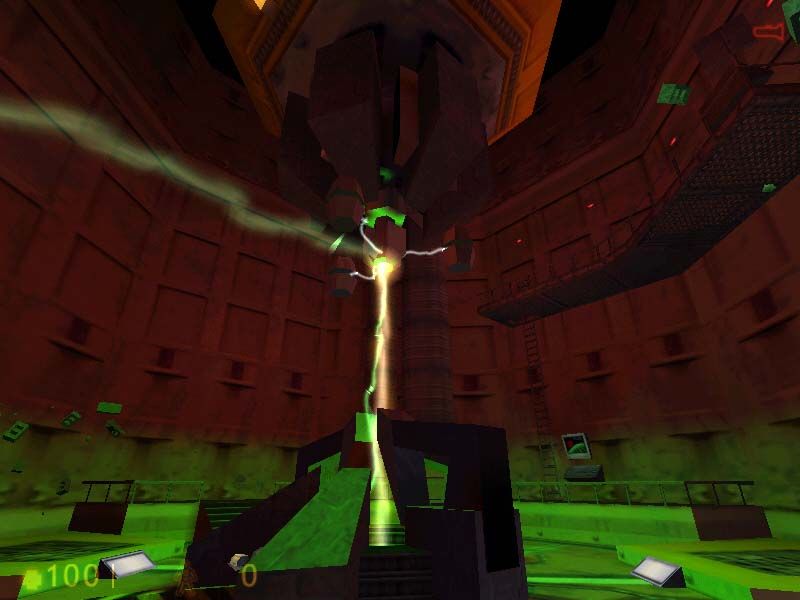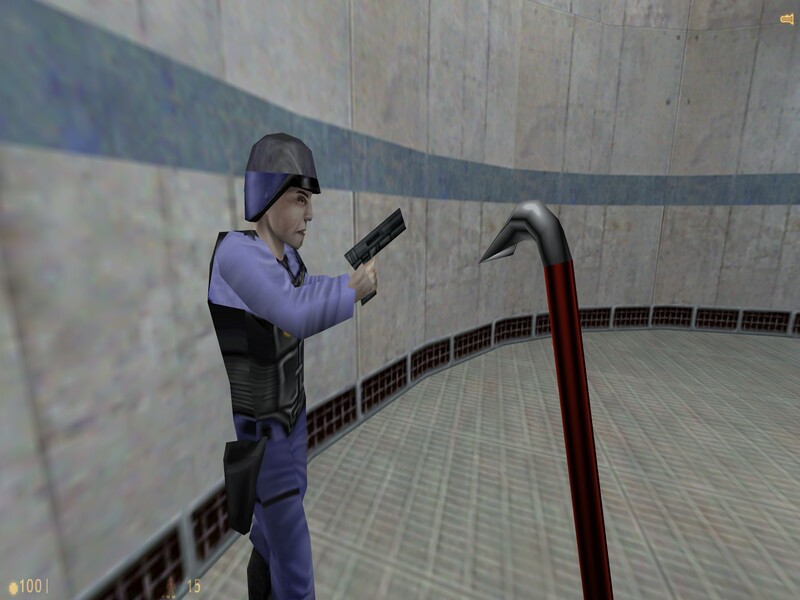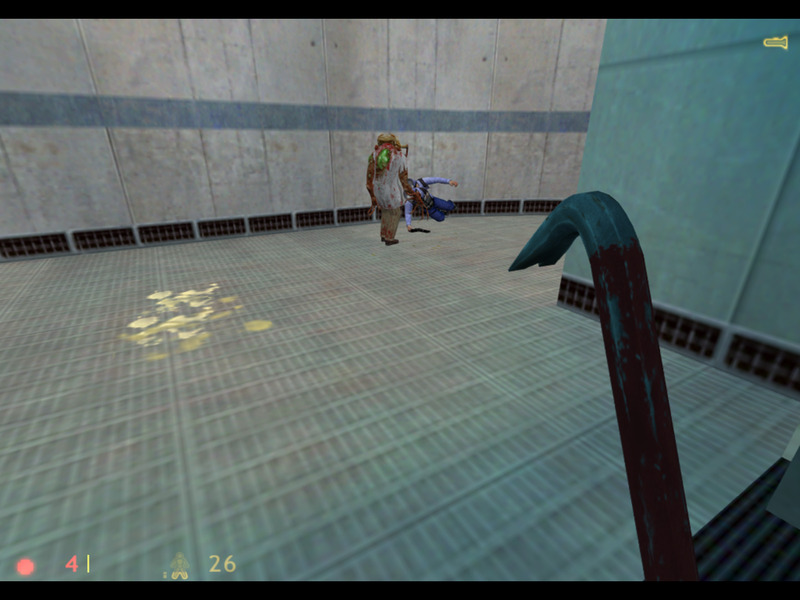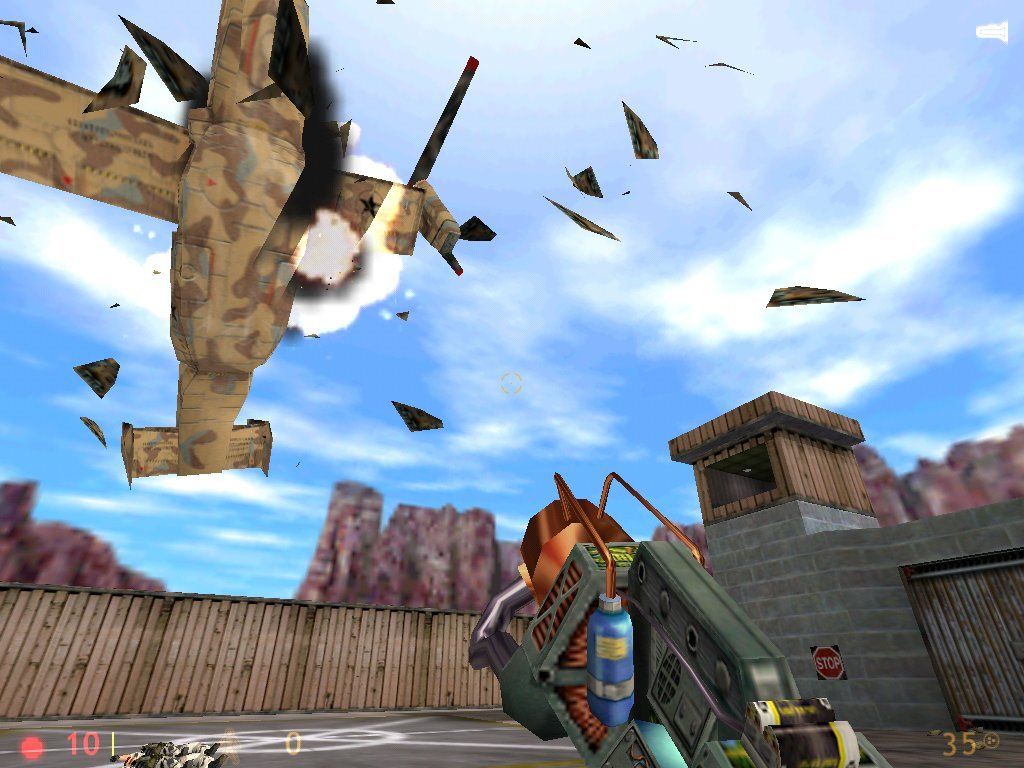“How do you make a small fortune in tabletop gaming?” runs an old joke.
The punchline, of course, is that you come to that market with a large one.
The tabletop truly is a brutally challenging place to try to earn money, one which you have to be either wildly deluded or unbelievably passionate to even contemplate entering. Nevertheless, people have been making a go of it there for quite some decades by now. We’ll give them the benefit of the doubt and assume that love rather than mental illness is the motivating force. For, whatever else you can say about these folks, nobody is more passionate about their hobby than old-school tabletoppers.
If you do dare to dream of making real money on the tabletop, there are two ways you might envision doing so. One is to strike gold with a once-in-a-blue-moon mass-market perennial of the sort that eventually winds up in every other family’s closet: a Monopoly, a Scrabble, a Clue, a Trivial Pursuit. Under this model, you sell that one game to tens if not hundreds of millions of people, the majority of whom might not buy another board game for five or ten years after buying yours.
The other pathway to profit — or at least to long-term survival — is to score a hit in the hobbyist market. Here your sales ceiling is much lower. But, because you’re selling to people who see tabletop gaming as a lifestyle rather than a gambit to divert the kids on a rainy afternoon, you can potentially keep selling them additions to the same basic game for years and years, turning it into not so much a single product as a whole ecosystem of same. It’s a tougher row to hoe in that it requires an ongoing effort on your part to come up with a steady stream of new content that appeals to your customers, but it’s marginally more achievable than winning the lottery that is the mass market.
That said, any given game need not be exclusively of the one sort or the other. Crossover hits are possible and even increasingly common. In recent decades, several hobbyist games — among them titles such as Catan, Carcassonne, and Ticket to Ride — have proved to possess the necessary blend of relatability, simplicity, and fun to be sold in supermarkets and greeting-card shops in addition to the scruffy hobbyist boutiques.
Way back in the early 1980s, Dungeons & Dragons was successful enough that its maker, the Lake Geneva, Wisconsin-based TSR, dared to wonder whether that game might be able to make the leap to the mainstream, however strange it may have seemed to imagine that an exercise in elaborate make-believe and tactical monster-fighting might have the same sort of legs as Monopoly. After all, despite its complexity and subject matter, Dungeons & Dragons was already far more culturally visible than Monopoly, a fixture of school cafeterias and anti-Satanic evangelical sermons alike.
Alas, it was not to be. The Dungeons & Dragons wave crested in 1982, after which the bandwagon jumpers began to jump off the wagon again. True mass-market success was probably never in the cards for a company whose acronym stood for “Tactical Studies Rules.” Luckily for TSR, they retained a core group of loyalists who were willing to splash out considerable sums of money on their hobby. Indeed, for a goodly while it seemed like they would snatch up as much new Dungeons & Dragons product as TSR cared to throw at them.
A new era of Dungeons & Dragons merchandising dawned in 1984, when TSR rolled out a trans-media property known as Dragonlance: twelve individual adventure modules, plus two source books and even a strategic board game, all meant to allow a group of players to interactively experience an epic tale of fantasy war that could also be read about in a trilogy of thick conventional novels, the first of their kind that TSR had ever published. It was a brilliant conception in its way, and it became hugely popular with the fan base, heralding a slow shift in TSR’s rhetoric around Dungeons & Dragons. In the past, it had been promoted as a game of free-flowing imagination, primarily a system for making up your own worlds and stories. In the future, the core rules would be marketed as a foundation that you built upon not so much with your own creativity as with other, more targeted TSR products: settings to inhabit, adventures to go through in those settings, new rule books to make a complicated game still more complicated.
The transaction was not so cynical as I might have made it sound. The products themselves were often excellent, thanks to TSR’s dedicated and imaginative staff, and many or most fans felt they got fair value for their ongoing investment. Yet the fact remained that this was also TSR’s only viable way of remaining solvent after the mainstream culture had dismissed Dungeons & Dragons as a weird, kitschy fad or a shorthand for abject nerdiness.
As it was, though, TSR coasted along fairly comfortably on these terms for quite some years. The Dungeons & Dragons supplements continued to sell, even after there were so many of them that it was difficult to see how even the most committed zealot could possibly find the time to get more than a tiny percentage of them to the table. (TSR doubtless benefited from the fact that a lot of fans could get pleasure out of the source books without ever using them for their intended purpose: a surprising number of people over the years have told me that they liked to read such books just to appreciate the meticulous world-building.) The release of a modestly revised “Second Edition” of Advanced Dungeons & Dragons in 1989 sent the fans scrambling to re-buy a game they already owned, if for no other reason than to stay compatible with that fire hose of adventures and supplements. Meanwhile TSR found an unexpectedly rich new revenue stream in the many Dungeons & Dragons novels that followed in the wake of that first Dragonlance trilogy; the sales of virtually any of these dwarfed the unit sales of the typical gaming product, while the most popular of all among them, such as R.A. Salvatore’s tales of the dark-elf ranger Drizzt, climbed high on the New York Times bestseller charts. Add to this a deal with SSI to make Dungeons & Dragons-branded computer games, five of which sold more than 100,000 copies from 1988 to 1991. Between the novels and the computer games, Dungeons & Dragons had become as much an abstract lifestyle brand as a concrete tabletop game by the beginning of the 1990s.
It was at about this time that it all started to go wrong — subtly wrong at first, then obviously, and then disastrously. The root of the rot is hard to pinpoint precisely, as these things always are.
Some people point as far back as 1985, when Lorraine Williams, a wealthy heiress who owed her fortune primarily to the Buck Rogers character of comic-book, movie-serial, and television fame, ousted Gary Gygax and took over the company in a palace coup. She is not, to say the least, a highly regarded figure among old-school Dungeons & Dragons fandom. For our part, we need to tread cautiously here; there’s an ugly undertone of gatekeeping and/or misogyny that clings to many fan narratives about Williams’s tenure at the head of TSR. Nonetheless, it is true that she had little intrinsic interest in Dungeons & Dragons; in fact, she sometimes seemed to regard the game’s fans with something perilously close to contempt. In the beginning, TSR was in a strong enough position to overcome her estrangement from the market she served. Later on, this would no longer be the case.
Other people prefer to point to 1991, when a new publisher called White Wolf released a tabletop RPG called Vampire: The Masquerade, which portrayed its titular monsters not as blood-sucking horrors but as sexy lovers of the night straight out of an Anne Rice novel. That, combined with its rules-light approach, attracted a whole new demographic who wouldn’t have been caught dead battling hobgoblins in a fantasy dungeon: too-cool-for-school Goths, who gave free rein to their inner fiends around the gaming table in between Cure concerts. Even in its allegedly streamlined second edition, Advanced Dungeons & Dragons looked stodgy and pedantic to the eyes of many gamers when compared with its younger, slicker competition. For arguably the only time in the entire history of the tabletop RPG, there was real reason to question whether Dungeons & Dragons would continue to be the unrivaled giant of the field going forward. Sales of TSR’s rules and supplements fell off gradually, while sales on the digital front fairly fell off a cliff: no other Dungeons & Dragons computer game from SSI would come anywhere close to sales of 100,000 units after Eye of the Beholder in 1991.
Then, just when it looked like Dungeons & Dragons was at risk of losing its position at the top of the tabletop-RPG pile, another sort of game entirely came along to kick the whole stack right out from under all of them. In August of 1993, a little card game called Magic: The Gathering, designed by a graduate student in combinatorics named Richard Garfield and bearing the logo of a heretofore unsuccessful publisher of tabletop-RPG material named Wizards of the Coast, was debuted at the Gen Con trade show in Wisconsin — a show which had been started by Gary Gygax all the way back in 1968, and which was still put on every year by TSR. At this 26th installment of Gen Con, however, the talk was all about Magic rather than Dungeons & Dragons. Allen Varney later wrote in TSR’s own house magazine Dragon how
people clustered three deep around the Wizards of the Coast table, craning to see the ongoing demonstrations of this game. Everywhere I went I saw someone playing it. In discussing it, some players showed reserved admiration, others enthusiasm, but body language told more than words. Everyone hunched forward intently, the way you do in deep discussions of politics or religion. Onlookers and devoted fans alike felt compelled to grapple with the idea of this game. It achieved more than just a commercial hit; it redefined gamers’ perspectives on their hobby.
The scenes that Varney witnessed were a microcosm of what was about to happen to hobbyist gaming in general, as tabletop fantasy, for so many years a relatively stable market, was hit by this new, profoundly destabilizing force.
We can point to any number of grounds for Magic’s enormous appeal. Many of them boil down to convenience: it was quick to set up and could be played in twenty minutes or so by just two people, without either of them having to read much in the way of rules beyond what was printed on the cards themselves. (Compare this with needing to assemble at least four or five friends to play Dungeons & Dragons, as well as with that game’s hundreds of pages of rules, the crushing weight of preparation and responsibility it put on the Dungeon Master who guided the session, and its equally extreme demands of time; many a Dungeons & Dragons party hadn’t yet decided what equipment to carry into the dungeon by the time twenty minutes had elapsed.) Then, too, the Magic cards were beautifully illustrated, such that collecting them could become an end unto itself. Finally, add to all of this a feeling that had been setting in even before that pivotal Gen Con: that Dungeons & Dragons had become old hat, an artifact of the last two decades rather than this one. A new generation of gamers craved something fresh. For better or for worse, it seemed that Magic was that thing.
Magic became an unprecedented phenomenon in tabletop gaming, its astounding growth curve eclipsing by a veritable order of magnitude even the early days of Dungeons & Dragons. More than TSR ever had, Wizards of the Coast had well and truly mastered the art of making money in hobbyist gaming by selling the same group of people an infinite stream of content for the same basic game. They had mastered it so well, in fact, that there wasn’t much room left for TSR; a gamer who spent all of his allowance or paycheck on new Magic decks simply didn’t have any money left to give to Dungeons & Dragons.
Like many other shell-shocked publishers in the tabletop-RPG space, TSR tried to fight back by quite literally playing Wizards of the Coast’s own game. Already in 1994, they released a collectible card game of their own called Spellfire. It’s doubtful whether it would have been able to overcome Magic’s first-mover advantage even if its use of recycled, clashing artwork from previous eras of Dungeons & Dragons hadn’t made it look so much like the rushed knockoff product it was. TSR mustered a modicum more creativity for 1995’s Dragon Dice, which replaced collectible cards with — you guessed it — collectible dice. But it too failed to attract the critical mass of players it needed in order to become self-sustaining. Collectible anything games writ large were a zero-sum game, one in which all of the cards seemed to belong to Wizards and Magic.
Any reasonably thoughtful observer who looked at TSR from the outside at mid-decade would have seen a deeply troubled company, whose flagship game was shrinking away before its eyes. Only one fact might have tended to disabuse our observer of that notion: the fact that TSR kept pumping out product for that same incredible shrinking game at a more furious pace than ever. And make no mistake: TSR’s tabletop Dungeons & Dragons products weren’t slapdash in the way of Spellfire. They were crafted with self-evident love and care, were beautifully illustrated and packaged. The mystery was how the company could afford to put out so darn much quality content in the face of so many financial headwinds. By 1995, TSR had no fewer than twelve separate Advanced Dungeons & Dragons campaign settings on the market, each of them taking the form of a mouth-wateringly lavish and rather pricey boxed set. J.R.R. Tolkien and Jack Vance were no longer the alpha and omega of Dungeons & Dragons. You could now play in a post-apocalyptic milieu, in a surrealistic alternate dimension worthy of a Salvador Dali painting, or in outer space. If you liked vampires and gothic horror, you could even play with them without having to jump ship to White Wolf, by picking up a copy of Ravenloft. Committing one’s regular gaming group to any one of these settings meant forgoing all of the others for months or years to come. Even if our observer recognized that a high percentage of customers bought the boxed sets just to browse them and dream about what they might do with them someday, the deluge of content still seemed out of all proportion to the shrinking market for Dungeons & Dragons in general.
Really: just who was buying up enough of this content so that TSR had the money to keep putting out still more of it? The answer to that question would have stunned our hypothetical mid-1990s observer.
In the book Slaying the Dragon, his 2022 “Secret History of Dungeons & Dragons,” Ben Riggs pulls back the curtain on the perverse incentives that were dictating much of TSR’s publication schedule by this point. Since the first incipient rumblings of a full-blown Dungeons & Dragons fad back in 1979, TSR had used the print-publishing mega-corporation Random House as their vehicle for getting product into bookstores. That is to say that TSR continued to act as their own publisher, but they used Random House as their distributor. In a normal arrangement of this sort, the publisher sends their products after they’ve been printed to their distributor, who stashes them in a warehouse and proceeds to take orders from retail stores. As orders come in, the distributor ships out the products, and sends back to the publisher the price of each order, minus the distributor’s own cut for services rendered. Many contracts do allow retailers to send back products that have sat on the shelf for a given span of time without selling, but we need not get into those complications here, because the contract that TSR had with Random House was a highly unusual one in another respect.
Instead of paying TSR as retail stores ordered their products, Random House paid for each shipment up-front, as soon as it arrived at their warehouse, and then tried to recoup that money by selling it on to retail. If we squint just right, we can see why Random House might have agreed to such a seemingly disadvantageous arrangement back in 1979. At that time, TSR might have looked to be a rising star, but they were still rather cash- and investment-poor. On the theory that it’s best to strike while the iron is hot, it might have made sense to someone at Random House to give TSR a way to produce more products more quickly, without having to wait for the revenues from the earlier ones to filter back into their coffers. But the inadvertent byproduct was to break the most fundamental laws of capitalism. “The printing of products was essentially the printing of money,” writes Ben Riggs. “The company had broken free of supply and demand. Perhaps this is why the company kept making settings, even though almost every new iteration sold less than the last one.” The logic was as simple as it was degenerate: if you weren’t making enough money on Dungeons & Dragons, the best remedy was to make more Dungeons & Dragons and send it to Random House. Let them worry about finding a way to unload the stuff.
There was just one problem with that formulation: the payment which Random House sent back to TSR upon receiving each truck-load of product was actually considered to be a loan, unless and until Random House recouped their costs through sales to retailers. The checks from Random House turned into an unpaid bar tab that just kept building and building while Dungeons & Dragons’s retail sales went south. Whether out of benevolence or just because they weren’t really paying attention, Random House was remarkably patient about demanding that TSR settle their tab. But by mid-1995 TSR owed Random House $12 million, with no realistic prospect at current sales volumes of paying off the debt. How long could the mega-corporation’s largess persist?
On every front, TSR was now scrabbling for traction. The digital realm was looking as ugly as that of the tabletop, as SSI’s latest computer games struggled to compete amidst a new fixation on fast-paced real-time as opposed to turn-based forms of gameplay and a more generalized CRPG downturn in the marketplace. After 1993’s Dark Sun: Shattered Lands, which was supposed to be something of a reboot for the Dungeons & Dragons brand on computers, sold fewer than 50,000 copies, TSR began looking for alternatives to SSI. In truth, while SSI had certainly done the license few favors of late — they had released too many games too quickly, with too many of them of workmanlike quality at best — the brand’s woes on the computer went well beyond one injudicious publisher. The malaise of the tabletop was no less prevalent on the digital side of the divide. Dungeons & Dragons just didn’t seem cool anymore — not even nerdy cool.
Nevertheless, TSR terminated their exclusive contract with SSI as soon as it was possible to do so. It came to an end on January 1, 1995, although SSI was given a grace period of six months to put out the last games they had in the pipeline on a non-exclusive basis. Instead of signing another all-encompassing deal like the one they had had with SSI, TSR opted for a bespoke approach, allowing individual publishers to come to them with proposals for individual games. In 1996, Acclaim Entertainment released a rather lame Dungeons & Dragons-branded action game called Iron & Blood: Warriors of Ravenloft (“NO 3-D FIGHTER CAN MATCH THE BRUTAL ACTION OF IRON & BLOOD!”). Blood & Magic, which Interplay published later that year, was a real-time-strategy game that Computer Gaming World magazine felt free to dismiss as “a poor man’s Warcraft — and mind you, I’m comparing it to the original, not the sequel.” In 1997, Sierra delivered a more conceptually interesting but poorly executed CRPG/strategy hybrid called Birthright: The Gorgon’s Alliance. These publishers were most definitely not trying to recreate the Dungeons & Dragons tabletop experience on computers, as SSI had so earnestly strained to do in the days of Pool of Radiance. They viewed the Dungeons & Dragons name, which was selling at a steep discount by now, merely as a way to squeeze a few extra unit sales out of the mediocre games to which they applied it.
By the time the aforementioned computer games appeared, TSR was well into its death spiral. At this point, even the Dungeons & Dragons novels, for years the company’s most stable income stream, weren’t selling like they used to. The market had become over-saturated with these things too — TSR published fourteen of them in 1994 alone — even as the brand’s innate cachet had declined and the most popular authors of the past, most notably R.A. Salvatore, had been lost to other book publishers who tended to pay far better.
Unsurprisingly, the beginning of the end came when Random House got serious at last about trying to get their money back. In the summer of 1995, they forced TSR to agree to a debt-repayment plan. TSR was to reduce their outstanding obligation from $12 million to $8.2 million by the end of the year, then pare it down to less than $1 million by the end of 1996. If TSR failed to do so, Random House said, they would initiate legal proceedings to recover the money they were owed.
To their credit, TSR did make an effort to meet Random House’s terms. They were able to reduce the debt to $9.5 million by early in 1996, largely on the strength of the novel Dragons of Summer Flame, a much-hyped continuation of the original Dragonlance saga by Margaret Weis and Tracey Hickman, the primary architects of the mid-1980s trans-media project that still stood as such a landmark in the history of Dungeons & Dragons. But a demonstration of good-faith effort was no longer good enough in the opinion of Random House; their forbearance had run out. In April of 1996, they sued TSR for the remaining millions, just as they had said they would. At the same time, they stopped accepting more product from TSR for distribution — a sensible policy under the circumstances, given that every book, supplement, or game that arrived at their warehouse only added to the debt they were trying to collect. Yet this move deprived TSR of the better half of their distribution network, making the prospect of another fluke hit like Dragons of Summer Flame that much more unlikely.
It was right about this time that TSR stopped paying the majority of their bills. Authors stopped receiving their royalty checks, and TSR’s printer too went uncompensated. Desperate to head off a lawsuit from the latter on top of the one they were facing from Random House, TSR resorted to giving them their offices, then leasing the premises back. In another delaying tactic, TSR pledged the Dungeons & Dragons trademark itself, the crown jewel of their intellectual property, as collateral on their debt to Random House. Needless to say, such last-ditch machinations could only put off the inevitable final reckoning.
The layoffs began in December of 1996. There was a poignancy to these that vastly exceeded the loss of any ordinary job. The people who worked at TSR, more often than not for shockingly low salaries, did it purely out of passion. All of the content they churned out may have made no economic sense, but one only has to glance through the books to see the amount of love and care that was put into them. There was literally no other job in the world like a job at TSR. I can’t help but be reminded of the 1989 shuttering of Infocom, another sui generis creative collective. Ben Riggs:
What do you do, what do you say, when someone is fired from TSR? What would their next job be? Teacher? Journalist? Marketing? Whatever it was, you wouldn’t be working on Dungeons & Dragons. You wouldn’t be paid to think about bugbears, beholders, or bladesingers. For some, leaving the company wasn’t just losing a job, it was leaving a life…
The annual Christmas party turned into a wake for the departed, who were toasted by surviving comrades who knew that their own turn must be coming soon. For it was hard for anyone at TSR to see how the company could possibly recover. Sure enough, within days of the Christmas party, TSR’s printer/landlord stopped printing anything at all for them and initiated eviction proceedings to claim their office space for paying tenants.
Few at TSR realized that a way out had been available to Lorraine Williams for a couple of years by this point. Peter Adkison, the founder and head of Wizards of the Coast, was in a rare position for a chief executive in the tabletop industry: that of running a company that was flush with cash. Despite having done so much to engineer TSR’s doom through Magic, he was very fond of Dungeons & Dragons, and believed that the game and the brand could be resuscitated and made (nerdy) cool again if it was just managed and marketed properly. And unlike TSR, he was in a position to pour serious resources into that task, thanks to his Magic money-printing machine. He let it be known that he would be very interested in doing a deal.
And yet his feelers were steadfastly ignored for two years. Lorraine Williams had an intensely personal loathing for Adkison and his company. Even as Magic had been devouring Dungeons & Dragons at the cash registers of hobby shops, Wizards had repeatedly upstaged TSR in other ways, making tabletop gaming’s lion in winter look stodgy and out of touch over and over again.
Take, for example, the respective reactions to the nascent World Wide Web. TSR saw the fans who flocked online to discuss their hobby and share their ideas, experiences, and creations mostly as a threat to their intellectual property. A set of “guidelines” issued by TSR in 1994 is breathtaking in its wrong-headedness; it essentially makes a “no Dungeons & Dragons allowed” zone out of the entire Internet, with the threat of legal action lurking not so subtly behind its words.
If the party encounters a hydra, let the game master look up the stats for the hydra in the game system he is using. Don’t set the adventures in a TSR world. Create your own or use one from history or legend. Don’t use monsters, spells, etc. that were created by TSR. Create and name your own. Draw on history, legend or reality. Even spell their actual names backward for uniqueness.
Threatening one’s most devoted customers is not a good way to inculcate trust and loyalty in them; nor is forcibly silencing them a good way to spread the word about one’s products. The fans decided that the TSR acronym must really stand for “They Sue Regularly.”
Peter Adkison, on the other hand, recognized the enormous potential of the new digital medium of instant worldwide communication whose rise coincided almost exactly with that of Magic. He made sure Wizard’s site was one of the most advanced on the young Web, granted lengthy interviews to the most prominent of the third-party sites that were soon springing up by the dozen each month, and made no move to interfere when fans began using the Internet to buy and sell Magic cards, at a time when e-commerce in general was still little more than a gleam in a few venture capitalists’ eyes. Such a grass-efforts grapevine was, he knew, better publicity than he could buy with millions of dollars of worth of traditional advertising. It’s no wonder that Lorraine Williams grew to hate him so. To her, he must have seemed bent on demonstrating to the world every single day how much cleverer and more clued-in he was. Even with her own company sinking beneath her feet, Williams refused to countenance climbing onboard her one available lifeboat.
The impasse was finally broken by a wily third party named Bob Abramowitz. Abramowitz was the CEO of yet another game publisher, an outfit called Five Rings Publishing whose flagship product was a collectable card game called Legend of the Five Rings. He met Lorraine Williams at the American International Toy Fair in February of 1997. (Incredibly, she was still attending such events at this late juncture, even though her company was now utterly paralyzed, thanks to their angry printer who refused to accept new jobs.) Being well acquainted with the rumors that were swirling around the industry about TSR’s dire straits, Abramowitz broached a visit to their Lake Geneva headquarters to kick the tires and discuss a possible purchase, even though he knew full well that he was possessed of nothing like the financing that would be necessary to pull off such a deal.
Luckily for him, Williams invited him to come on out without bothering to check his bona fides. Over the course of several days in Lake Geneva, he and a couple of associates pored over TSR’s books, learning to their shock that things there were actually much, much worse than they had ever dreamed they might be. Abramowitz would later describe how “in the halls that had produced the stuff of my childhood fantasies, and had fired my imagination and become unalterably intertwined with my own sense of self, I found echoes, empty desks, and the terrible depression of lost purpose.” At the end of the visit, Abramowitz and Williams signed a formal letter of intent, in which the latter stated that she was prepared to sell TSR to the former for $25 million. Because any such sale would come complete with $30 million in unpaid debts, the effective price tag would amount to about $55 million.
In reality, Abramowitz hadn’t a prayer of raising even $25 million. What he did have, however, was a plan. He finagled a meeting with Peter Adkison and showed him the letter of intent. It proved that Williams was willing and even eager to sell her company in principle. The sticking point was whether she could be convinced to sell it to Peter Adkison and Wizards of the Coast. Having gotten this far with her, Abramowitz thought he could talk her around to that distasteful prospect. He was prepared to try his hardest to do so — as long as Adkison agreed to also buy Five Rings, whose own collectible card game was struggling mightily to compete with Magic.
“But why not just let TSR go bankrupt, and then buy it without assuming all that debt?” Adkison asked.
“Because,” Abramowitz explained, “the trademarks are already mortgaged. What’s valuable here isn’t TSR itself. It’s Dungeons & Dragons. The only way you can be sure of getting it is to buy the whole company now, while it’s still intact.”
Adkison tried a bit more to play devil’s advocate, but his heart wasn’t really in it. Abramowitz had already seen his interlocutor’s eyes light up when he had first mentioned a deal involving TSR and Dungeons & Dragons. He had known then and there that he had hooked his whale.
His plan worked like a charm. He flew back to Lake Geneva, and, in the course of a tense 90-minute conversation, convinced Lorraine Williams to sell her company to the last person in the world she wanted to. Then he sold Five Rings as well to Wizards, walking away from the spate of deal-making rid of that money-losing albatross and with a substantial sum of cash for the pockets of him and his partners. Bravo for him.
The impending purchase was announced on April 10, 1997; the sale was finalized on June 2. By this point, Wizards was a far bigger, wealthier company than TSR had ever been. They were able to buy TSR and bulldoze away the mountain of debt without taking any new bank financing of their own — so much money were they bringing in through Magic.
Peter Adkison held an all-hands meeting with the understandably nervous remaining staff of TSR on June 3. At it, he told them that he had bought the company for two things: for Dungeons & Dragons, yes, but also for the very people who were gathered in that room, the ones who made the game. TSR’s Lake Geneva offices would be closed, marking the end of Wisconsin’s unlikely tenure as the center of the tabletop-RPG universe, but most employees would receive an offer to move to Seattle and work in Wizard’s headquarters. With Magic doing such gangbusters business, Wizards of the Coast had the time and money to rebuild the Dungeons & Dragons brand carefully and methodically, even if it took years. They would soon begin work on a third edition of the rules, the most sweeping revision ever, intended to make the game understandable and appealing to a whole new generation of players without losing the core of what had made it such a sensation in the first place. The future of Dungeons & Dragons was bright, Adkison insisted.
What Adkison couldn’t have envisioned on that day was that the resuscitation of Dungeons & Dragons would begin in the digital rather than the tabletop realm, courtesy of one of the most iconic CRPGs of all time — a Pool of Radiance for this new decade.
Did you enjoy this article? If so, please think about pitching in to help me make many more like it. You can pledge any amount you like.
Sources: The books Beneath a Starless Sky: Pillars of Eternity and the Infinity Engine Era of RPGs by David L. Craddock; Designers & Dragons: A History of the Roleplaying Game Industry, Volumes 1 and 3, by Shannon Appelcline; Slaying the Dragon: A Secret History of Dungeons & Dragons by Ben Riggs; and Generation Decks: The Unofficial History of Magic: The Gathering by Titus Chalk; Game Wizards: The Epic Battle for Dungeons & Dragons by Jon Peterson. Dragon of January 1994; Computer Gaming World of April 1997.
Online sources include DM David’s blog, especially “TSR Declares War on the Internet’s D&D Fans” and “The Threat That Nearly Killed Dungeons & Dragons — Twice.”
I also made use of the SSI archive donated by Joel Billings to the Strong Museum of Play.

